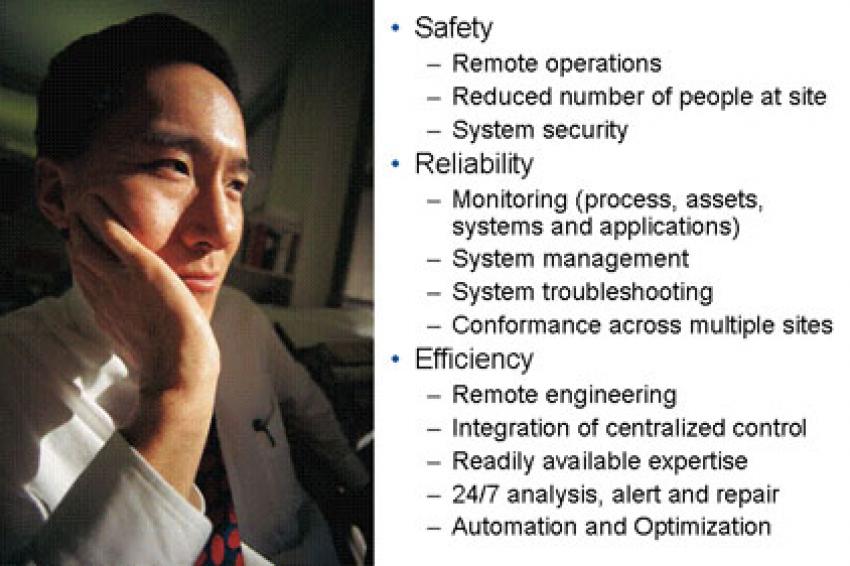Safety, Reliability and Efficiency
Remote Process Control Network (PCN) Monitoring
Effective Integration - Managing a complex Distributed Control System (DCS) running various critical business and control applications requires a significant investment in resources. Ensuring Microsoft security patches, system administration, firewalls and antivirus updates are managed, in addition to the normal day to day system changes, leaves little time to ensure the system is running at top efficiency. Add to this situation limited on-site expertise in open systems and you are left with a situation where site personnel are overloaded and under-trained and therefore unable to adequately monitor the systems. The result is missed warnings that would have prevented problems from occurring and extended system downtime trying to resolve these issues.
This is where process automation/knowledge system vendors, such as Honeywell, can assist. By providing remote 24/7 expertise, they can address these challenges; securely, professionally and efficiently. This results in customer savings from the incremental cost of adding staff, thus freeing up valuable resources to focus on core, higher value activities. The added bonus of remote performance monitoring is automated alerts and immediate access to system experts.
What Should Be Provided?
For an integrated remote monitoring solution to be effective, it needs to coordinate between the various vendor experts and the site's process control, IT and operations groups, as well as to the process automation system. Initial planning must include the key site resources to ensure a thorough understanding of the site's needs, including threshold sensitivity, response times and cyber security requirements. Continuous connectivity and automated analysis are critical to ensuring problems are identified and resolved quickly. Secure access to the site data by remote experts allows for faster problem resolution. Baseline and periodic reports with expert analysis and recommendations allow the customer to better manage their system, both for short term changes and longer term planning.
Once the secure monitoring system is in place, a baseline should be documented and 24/7 monitoring with automated alerts established. These automated alerts, issued by e-mail or text messaging, will provide immediate notification of critical threshold breaches or failed services and should be configurable to meet the customers' unique operational requirements and support infrastructure. The alerts should provide hyperlinks to key user documentation associated with the type of alert to help resolve the problem quickly.
These alerts can go directly to the customer, to a local service engineer, to the vendor's remote technical support center or a combination of these key technical resources to ensure all the right people are engaged in resolving the problem. The result is a constant collaboration between the vendor and the customer regarding real time system health status. In addition to remote system trouble monitoring, the data is also used to generate performance baselines to evaluate the impact of software or hardware updates to predict when day-to-day system management changes will affect performance and to better plan for system upgrades. Manual evaluation of the data will also identify system management practices that could be improved upon, such as graphic performance, peer-to-peer loading and even network data routing.
What is the Value to the Customer?
For customers whose system performance does not meet expectations, or who desire continuous process automation performance improvement and would like to bridge their knowledge gaps to achieve desired financial performance of their existing assets; remote monitoring provides real time expert system monitoring resulting in the following key benefits:
• Safety
o Reduced number of people needed at a remote or dangerous location
o Identification of system problems before they create safety issues
• Reliability
o The ability to readily manage physical assets
o Improved system reliability
o Ability to maintain conformance across multiple sites
• Efficiency
o Increased productivity
o Improved system and security performance tracking
o Immediate access to vendor expertise
o Tracking of critical patch and anti-virus deployment
o Consistent support across multiple sites and geographies
Summary
Open technology in the process control industry creates added demands but at the same time offers new technology to make the management tasks more flexible. Remote performance monitoring provides a means to establish a baseline to compare to dynamic monitoring and alerting capabilities that could not otherwise be achieved cost effectively.
The key components of a remote monitoring solution include a secure infrastructure both at the customer site and at the vendor's data center, knowledge of what key parameters to watch, the safe frequency to capture, the thresholds to use as a guide, and actions or recommendations on what to do when a threshold is breached, such as additional automated data capture, alerts or automated actions such as service restarts.
A properly established remote monitoring process will result in improved system performance and significant cost savings over the life of the system.
Contact
Honeywell GmbH
Strahlenbergerstr. 110 -112
63067 Offenbach
Germany
+49 69 8064 723
+49 69 8064 97723






